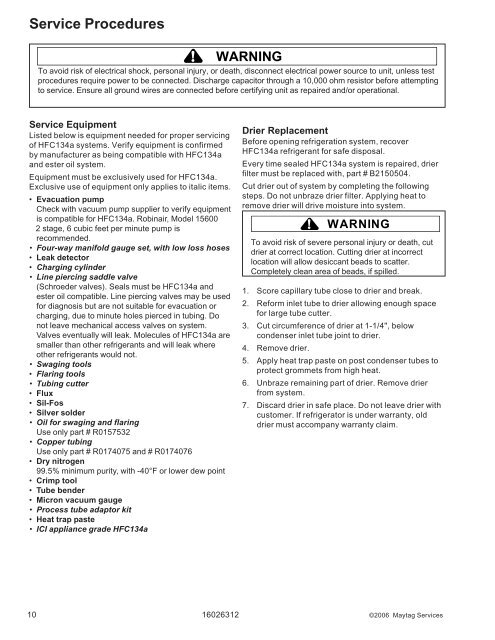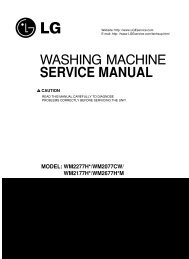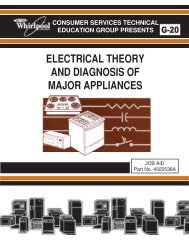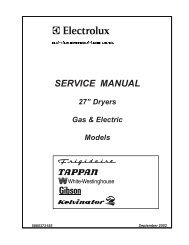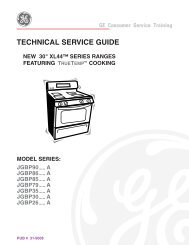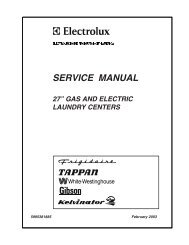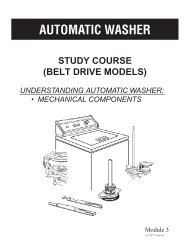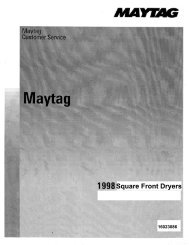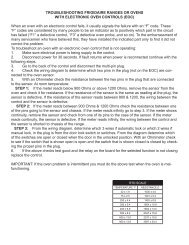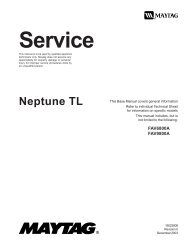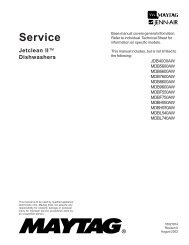MFI2568AES Service Manual - Appliance 911 Sea Breeze
MFI2568AES Service Manual - Appliance 911 Sea Breeze
MFI2568AES Service Manual - Appliance 911 Sea Breeze
You also want an ePaper? Increase the reach of your titles
YUMPU automatically turns print PDFs into web optimized ePapers that Google loves.
<strong>Service</strong> Procedures<br />
! WARNING<br />
To avoid risk of electrical shock, personal injury, or death, disconnect electrical power source to unit, unless test<br />
procedures require power to be connected. Discharge capacitor through a 10,000 ohm resistor before attempting<br />
to service. Ensure all ground wires are connected before certifying unit as repaired and/or operational.<br />
<strong>Service</strong> Equipment<br />
Listed below is equipment needed for proper servicing<br />
of HFC134a systems. Verify equipment is confirmed<br />
by manufacturer as being compatible with HFC134a<br />
and ester oil system.<br />
Equipment must be exclusively used for HFC134a.<br />
Exclusive use of equipment only applies to italic items.<br />
• Evacuation pump<br />
Check with vacuum pump supplier to verify equipment<br />
is compatible for HFC134a. Robinair, Model 15600<br />
2 stage, 6 cubic feet per minute pump is<br />
recommended.<br />
• Four-way manifold gauge set, with low loss hoses<br />
• Leak detector<br />
• Charging cylinder<br />
• Line piercing saddle valve<br />
(Schroeder valves). <strong>Sea</strong>ls must be HFC134a and<br />
ester oil compatible. Line piercing valves may be used<br />
for diagnosis but are not suitable for evacuation or<br />
charging, due to minute holes pierced in tubing. Do<br />
not leave mechanical access valves on system.<br />
Valves eventually will leak. Molecules of HFC134a are<br />
smaller than other refrigerants and will leak where<br />
other refrigerants would not.<br />
• Swaging tools<br />
• Flaring tools<br />
• Tubing cutter<br />
• Flux<br />
• Sil-Fos<br />
• Silver solder<br />
• Oil for swaging and flaring<br />
Use only part # R0157532<br />
• Copper tubing<br />
Use only part # R0174075 and # R0174076<br />
• Dry nitrogen<br />
99.5% minimum purity, with -40°F or lower dew point<br />
• Crimp tool<br />
• Tube bender<br />
• Micron vacuum gauge<br />
• Process tube adaptor kit<br />
• Heat trap paste<br />
• ICI appliance grade HFC134a<br />
Drier Replacement<br />
Before opening refrigeration system, recover<br />
HFC134a refrigerant for safe disposal.<br />
Every time sealed HFC134a system is repaired, drier<br />
filter must be replaced with, part # B2150504.<br />
Cut drier out of system by completing the following<br />
steps. Do not unbraze drier filter. Applying heat to<br />
remove drier will drive moisture into system.<br />
!<br />
WARNING<br />
To avoid risk of severe personal injury or death, cut<br />
drier at correct location. Cutting drier at incorrect<br />
location will allow desiccant beads to scatter.<br />
Completely clean area of beads, if spilled.<br />
1. Score capillary tube close to drier and break.<br />
2. Reform inlet tube to drier allowing enough space<br />
for large tube cutter.<br />
3. Cut circumference of drier at 1-1/4", below<br />
condenser inlet tube joint to drier.<br />
4. Remove drier.<br />
5. Apply heat trap paste on post condenser tubes to<br />
protect grommets from high heat.<br />
6. Unbraze remaining part of drier. Remove drier<br />
from system.<br />
7. Discard drier in safe place. Do not leave drier with<br />
customer. If refrigerator is under warranty, old<br />
drier must accompany warranty claim.<br />
10 16026312 ©2006 Maytag <strong>Service</strong>s


